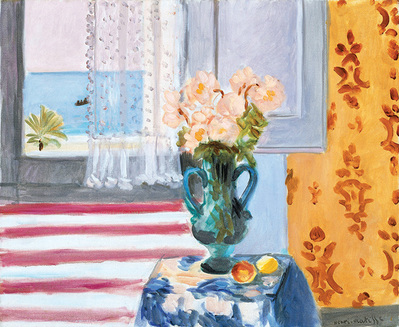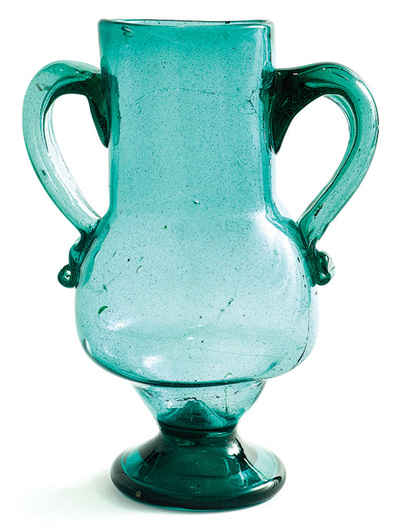Matisse in the Studio

Henri Matisse, Vase of Flowers, 1924, oil on canvas. Bequest of John T. Spaulding. © 2017 Succession H. Matisse/ Artists Rights Society (ARS), New York. Photograph © Museum of Fine Arts, Boston.
Far from drifting into the realm of art history, Henri Matisse remains vitally relevant as one of the great artists of the 20th century, one who, along with Pablo Picasso, helped remake our sense of what art could do and mean. Matisse’s work retains the ability to reawaken this sense, refreshing our engagement with art through its authenticity and purity of expression, divorced from cynicism and commercialism.
Matisse in the Studio, an expansive exhibition of major works from all periods of the artist’s career, provides the opportunity to engage with key elements of his mastery of color, line and imaginative transformation. On display are dozens of paintings, along with drawings, sculptures and cut-outs, interspersed with some of the objects—fabrics, carvings, vessels and furnishings from European, Islamic, Asian, African and other artistic traditions—once owned and kept close by Matisse through his many moves and travels. The exhibit focuses on the central but shifting, responsive and inspirational roles these items performed in Matisse’s dynamic practice and finished works.
The objects provided Matisse with more than just useful forms or decorative motifs. In his search for new approaches to rendering bodies and faces in his painting and sculpture, Matisse turned to African masks and carvings. These carvings were far from the mimetic, idealized approach prevalent in European academic art at the time. Instead Matisse saw in the carvings’ isolated and powerfully expressed body elements a symbolic emphasis that could help him achieve the effects he desired in his own work. The proportions, decoration and lines of a Mboom mask, for example, provided the conceptual and formal qualities Matisse used in Woman with a Veil (1927). The spatial cadences and emphatic articulation characteristic of items in Matisse’s African art collection emerged in the repeated forms, use of space and expressive proportions of his own sculptures, including Reclining Nude I (1907) and La Serpentine (1909).
An appliquéd tent curtain owned by Matisse appears here beside his Interior with Egyptian Curtain (1948), its color and scale altered and its pattern simplified and heightened to suit his vision for the painting. Providing a strong art- and pattern-making presence, the curtain contributes to a matrix balancing nature’s unbridled energy, represented by the palm fronds seen through the window, and the comforts and bounty achieved through nature’s cultivation, represented by the softly glowing golden orbs of fruit on the table.

Artist unknown, Vase, early 20th century, Andalusia, Spain, blown glass. Photo: François Fernandez. Former collection of Henri Matisse. Musée Matisse, Nice. Bequest of Madame Henri Matisse, 1960. Courtesy of Musée Matisse / Museum of Fine Arts, Boston.
Not all of the evocative objects in his paintings were collected on journeys or auction visits; some, such as the small, pale figure in Lilacs (1914), were of Matisse’s own making. Despite the loveliness of its eponymous flowers, Lilacs stands apart from most of the other paintings on view, lacking their bright light, vibrant color, assertive brushwork and profuse patterning. The enveloping darkness of Lilacs speaks of Matisse’s state of mind and of his ability to intertwine technique, image and emotion to represent it. The approach of World War I would have been devastating to Matisse, who grew up in a town repeatedly affected by conflict with Germany, including its occupation in his infancy during the 1870–71 Franco-Prussian war, ever after memorialized by his mother’s mealtime grace, “That’s another one the Germans won’t get.” Despite its tribute to spring and beauty, Lilacs expresses the deep anxiety, even horror that Matisse must have felt at war’s return. The blossoms, although encapsulated in protective auras, remain under threat of engulfment by the surrounding gloom. The wild and dark brushwork, the immateriality of the vase, the separated stems of the lilac spray and the mournful pose of the desolate, dwarfed figure below, a simplified rendering of Matisse’s own Small Crouching Nude with Arms (1908), express a despair countered only by the painting’s own testimony to the act of creation itself.
These transmutations provide insight into what Matisse described as wrestling with “the eternal question of the objective and the subjective.” Objects were actors, Matisse noted, and “a good actor can have a part in ten different plays; an object can play a role in different pictures.” From theatrical, complex interior scenes to simplified paper cut-outs, Matisse’s objects merged into imaginatively conceived wholes. As Matisse described the effect, “Expression for me does not reside in passions bursting from a human face, or manifested by violent movement…The entire arrangement of my picture is expressive: the place occupied by the figure, the empty spaces around them, the proportions, all of that has its share.”
